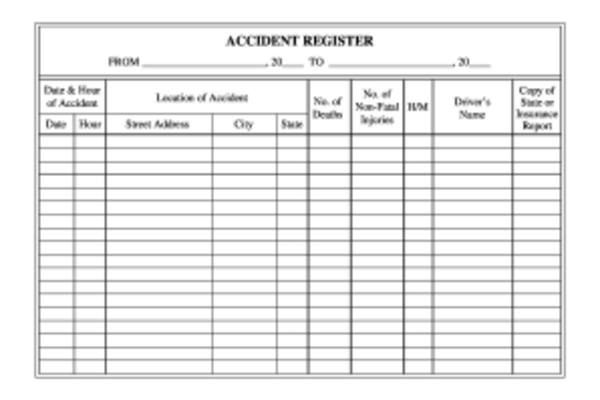Protecting Your Driver During Extreme Cold Conditions
Cold Weather Precautions To Prevent Hypothermia and Frostbite
Hypothermia occurs when the body's temperature falls below normal. Early and mild symptoms include shivering, slurred speech, mental slowness or lethargy, muscular stiffness, and clumsiness. Symptoms of severe hypothermia include mental confusion, disorientation, stupor or coma, absence of shivering, stiff or rigid muscles, shallow and very slow breathing, weak pulse, and a fall in blood pressure. If symptoms are detected, especially in the elderly, seek immediate medical help.
To prevent Hypothermia, take the following precautions:
- Wear several layers of warm, loose-fitting clothes. Items that wick moisture away from the skin are best.
- Use gloves and knit caps to keep heat in.
- Change clothing if it becomes wet.
- Have an emergency kit containing a change of clothes, a blanket, disposable hand and foot warmers, water, and snacks in case of being stranded.
- Eat hot, nutritious meals and drink water, this is important in the winter also.
- Make sure the driver has a way to communicate to you in the event of a breakdown of the unit in rural areas of operation.
Many prescription drugs may make you more sensitive to the cold, so check with your physician or pharmacist to find out if your medication falls in this category.
Frostbite, especially when the wind chill factor is very low, can be a problem. Symptoms of frostbite include: changes in skin appearance such as swelling, reddish, bluish or whitish coloring, numbness, stiffness or rigidity. If untreated, frostbite can lead to loss of frozen fingers, toes or other affected skin areas. To prevent frostbite, protect skin from direct exposure to cold air and from exposure to intense cold temperatures.
Time To Finalize Your Accident Documentation For 2020
All motor carriers operating CMV’s over 10,000 lbs. MGVWR, transporting HM in placardable quantities or transporting passengers are required to record accidents on a register by calendar year as defined in 49 CFR 390.51. Even if no accidents were incurred by the motor carrier, an accident register is required.
First, we need to establish the definition of an accident. According to the Federal Motor Carrier Safety regulations, the definition of an accident is as follows: An occurrence involving a commercial motor vehicle (>10,000 lbs. MGVWR, HM or Passengers) operating on a highway in interstate or intrastate commerce which results in:
1. A fatality.
2. Bodily injury to a person who, as a result of the injury, immediately receives medical treatment away from the scene of the accident.
3. One or more motor vehicles incurring disabling damage as a result of the accident, requiring the motor vehicle(s) to be transported away from the scene by a tow truck or other motor vehicle.
The term accident does not include:
1. An occurrence involving only boarding and alighting from a stationary motor vehicle.
2. An occurrence involving only the loading or unloading of cargo.
When an accident by the definition above occurs, the accident is required to be recorded on an accident register with the following information on the register:
1. Date of accident.
2. City or town, or most near, where the accident occurred and the State where the accident occurred.
3. Driver Name.
4. Number of injuries.
5. Number of fatalities.
6. Whether hazardous materials, other than fuel spilled from the fuel tanks of motor vehicle involved in the accident were released.
Motor carriers are required by regulation to maintain an accident register for three years after the date of each accident.
In addition to the register, the motor carrier is required to maintain copies of all accident reports required by State or other governmental entities or insurers.
The accident register is not required to be sent to the FMCSA or State but kept as part of your record keeping for the FMCSA to review during a compliance review or investigation.
As a “Best Practice” it is recommended that the motor carrier maintain two accident registers by calendar year:
1. DOT recordable accidents only
2. Non-DOT Recordable accidents.
The reasoning behind this practice is to provide the FMCSA on the information requested in a compliance review, and no more.
By having a second register with all accidents and incidents recorded the motor carrier can actively perform analysis of the losses and implement training to proactively reduce the frequency.
Accident registers can be kept electronically with a hard copy printed for the FMCSA upon request.
So where can I go to make sure that what I have on my register matches with the FMCSA?
You can view all your recordable accidents on the FMCSA Compliance, Safety and Accountability (CSA) Safety Measurement System (SMS) https://ai.fmcsa.dot.gov/sms
If the crash involves the release of hazardous materials, carriers must complete a hazardous incident report. See 49 CFR 171.15 and 49 CFR 171.16.
TSA Will Not Continue Authority To Extend HME Validity For CDL Drivers
The Transportation Security Administration has confirmed that after December 31, 2020, the agency will not continue authorization of State Driver Licensing Agencies to extend the validity of Hazardous Materials Endorsements that have expired.
The exemption was from renewal of the HME Security Threat Assessment for certain individuals that the agency published on April 8, 2020, which was extended through December 31, 2020.
Under this exemption, states may extend the expiration date of HMEs that expire on or after March 1, 2020, for 180 days, due to restrictions and business closures in place in response to the COVID–19 public health emergency. If a state grants an extension, the individual with an expired HME must initiate the process of renewing his or her security threat assessment (STA) for the HME no later than 60 days before the end of the state-granted extension.
Although companies are still reporting difficulty in arranging Security Threat Assessments in some States, drivers whose HMEs expire after January 1, 2021 must meet the fingerprint and background check requirements to renew their HMEs as previously scheduled.
FMCSA Proposes To Add Rear Impact Guards To Annual Inspections
The Federal Motor Carrier Safety Administration has published a proposed rule to include rear impact guards on the list of items that must be examined as part of the required annual inspection for each commercial motor vehicle. 85 Fed. Reg. 85571 (December 29, 2020).
In addition, FMCSA proposes to amend the labeling requirements for rear impact guards, and to exclude road construction controlled horizontal discharge trailers from the rear impact guard requirements, consistent with changes made by the National Highway Traffic Safety Administration to the corresponding Federal Motor Vehicle Safety Standards. NHTSA concluded that installation of rear impact guards on RCC horizontal discharge trailers would interfere with the intended function of the trailers and was therefore impracticable due to the unique design and purpose of those vehicles.








